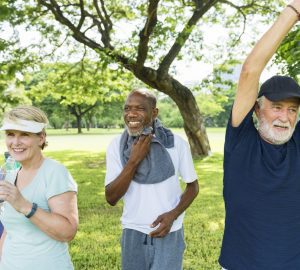New year new you, right? We tend to get caught up in thinking that just because it’s a New Year, we have to reinvent our core selves and take on lofty resolutions while developing a wellness plan. What if you already have everything it takes to live the life you want right now? With a little bit of introspection and a sprinkle of behavioural shifts, achieving the life you want is not hard.
Connect: To Others.
As humans, we have a biologic and evolutionary need to connect to others in a real way. Think about it, our ancestors formed actual TRIBES. Yes, they did it to stay safe and get food and procreate (if you didn’t have a tribe, you were eaten by a sabre-toothed tiger), but it’s also necessary for our happiness. Although the risk of getting eaten by a wild animal has decreased significantly, there’s nothing that’s changed about our evolutionary needs. We need other humans; real humans, not social media humans. Loneliness and social isolation (aka lack of connections to other humans) has been found to be a significant risk factors for early death. Despite being able to “connect” to anybody or anything anywhere in the world via social media, we are lonelier than ever.
The average person will spend more than five years of their life on social media. This puts daily usage of social media around 2 hours and 22 minutes per day and the average user scrolls though 300ft of content every day. There have been studies that link excessive passive screen time with a decline in well-being and life-satisfaction along with increased rates of depressive symptoms and suicidal thinking. There is a tendency to get caught up in comparison and in thinking that we need to be a different version of the person we are. Plus, being on our phone or device means we are likely MISSING actual connection to people right in front of us. Connecting to others via social media DOES NOT replace actual human connections while making a wellness plan.
Try this: Monitor your daily social media and screen use for one week, making NO changes. Then ask: where can I cut my screen time? What is this costing me? What else could I be doing instead of scrolling through social media? There’s nothing wrong with active use of social media platforms that you find inspiring or educational. The key is mindfully tuning in to when you’re passively scrolling the height of the Statue of Liberty and stopping it. Maybe you try substituting screen time for connection in the here-and-now and monitor what happens to your mood.
Challenge: Your mind.
As we pursue our goals in life, we’re all going to come up against challenges that may SEEM bigger than what we can manage. We may experience discomfort at the thought of potential failure. Our programmed biology under threat is to run, distract and avoid the perceived threats. We all do it.
What if you started to examine the ways in which you deal with challenges and tried noticing what maladaptive patterns you consistently engage in. Instead of being reactive and entering into automatic problem-focused coping, what if you considered the alternative; non-distraction, emotion-focused coping. Here, you have to pause and fight any urge to react right away or go into fix-it mode. Plus, you have to actually tune into the thoughts you’re having. There’s no room for passive avoidance or numbing away the problem with Netflix, substances or a shopping spree.
This form of coping invites the opportunity for cognitive restructuring or “reframing” the challenge.
Try This: The next time you have a significant challenge at work or in a relationship allow yourself time to pause. Make a wellness plan list of what thoughts or ideas you have about it. Listen to what your thoughts might be falsely telling you about the challenge. Are there common patterns of automatic thoughts (aka the instant thoughts your brain has in response to a stress)? Common unhelpful thinking styles can include:
- All or nothing thinking: ex: “I’m either going to succeed, or fail. There’s no in-between.”
- Fortune telling: ex: “What’s the point in trying, I know I’m not going to get the promotion anyway.”
- “Should” or “Not as good as” statements: ex: “Everyone else is better at sales, I shouldn’t even be in this profession.”
Ask:
- Is there another way to look at this situation?
- Do you have proof that what you’re telling yourself is true?
- What would you say to a friend who was thinking this way? If it differs than what you’re telling yourself, why?
Play: In body.
When was the last time you played? As in played to the point where you felt wild and silly and open and FREE (from judgments of yourself or others)? If you can’t think of the last time, the good news is that you’re not alone. The bad news is that you’re not truly living, and things need to change. We suggest SCHEDULING PLAY BREAKS in your wellness plan. If you think you don’t have time to schedule fun, we say think again. Fifty-five to seventy percent of our waking hours are spent sitting. Sitting time has increased by one hour per day over the past 10 years. Plus, for every hour spent sitting, mortality risk increases by 5.9% independent of your time spent physically active. If that’s not enough, research shows us that for every two hours of tv watching (think of the sedentary behavior that accompanies this activity) we increase our risk of obesity by 23%. YIKES!
So now that we’ve got your attention, you can understand how serious we are about play.
Try this: Every hour, get up, put on that favorite go-to song and walk it out, shake it out, sing it out or twirl it out. Just MOVE and invite in an opportunity for FUN. We urge you to make time for more things that arouse sensations of joy while reaping the physical health benefits. As you’re doing it, tune-in. Ask: Where do I feel joy in my body?
Grow: On purpose.
What do you want your life to stand for?
How do you want to live your life?
This brings us to Values. Getting clear on values is some of the most important work we may ever do. When we know our values, we can take action to live in accordance with them.
Our values are things we place importance on, and what we want our life to be about. It’s what we want to take into consideration when making big decisions. They are not to be confused with goals, or specific achievements we accomplish in the service of a particular value. Values guide our behavior, actions and decisions in life. They do not get rid of difficulties and stressors in life, but they can help up navigate the hardships with more clarity.
Try This: Start thinking about what your top 3-5 values are. Attempt to shift away from morality, and what you think you ‘should’ care about or were told to care about. Try to avoid choosing values that look good, or appeal to your desired self-image. We want to get clear on what matters most to us and what drives us to keep going despite the hardships and setbacks of life.
Remember, this is your life, and you get to choose your wellness plan. Be compassionate with yourself as you begin to shift from passively existing to actively living your life, on purpose.
This content is informational and educational, and it does not replace medical advice, diagnosis or treatment from your health professional. We encourage you to speak with your health-care provider about your individual needs.
By MC Bourque and Darby Ewashina – limbusmovement.com/









